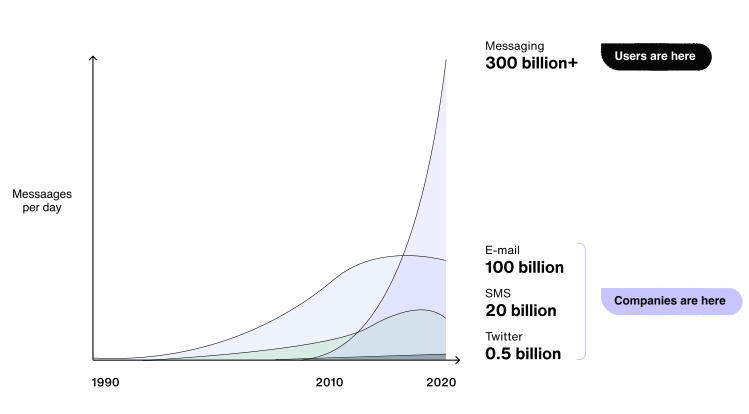3 predictions for the future of digital communication

When we talk about innovation around the dinner table with friends and family, the conversation often revolves around gadgets and hardware – the new iPhone that just came out, the plethora of new electric cars on the market, or perhaps a new watch that tracks your sleep and syncs with an app on your phone.
As humans pushed ahead with innovation, our interaction touchpoints and mediums have advanced as well, even when we are not in the same physical space. Advances in digital communication have blended so quickly and seamlessly into our daily lives that we don’t even think to call it out. Let’s look at how the primary mode of human communications outside of face-to-face interactions have evolved:
- Cave drawings (written messaging introduced)
- Smoke signals
- Carrier pigeons
- Horseback messenger
- Postal service
- Morse code
- Analog phone (voice introduced)
- Radio broadcast
- TV/screen (video introduced)
- Digital phone
- Desktop/laptop computer (email introduced)
- Mobile devices (SMS introduced)
- ____ What’s next?
In this blog, we’ll take a look at three major digital communications predictions for modern business, starting with the ever-evolving in-app messaging.

Future of digital communications prediction 1: In-app messaging takes over
Ok, we’re cheating a bit. This clearly isn’t a new trend. Rather, it’s doubling down on a trend that will accelerate. In 2020, the number of messages sent through mobile apps already surpassed 300 billion messages per day – outpacing SMS text messages by a multiple of 15 times. We wager that this number was even higher in 2022 and will carry over into 2023 and beyond.

8 major support hassles solved with AI agents
Every app developer and business has the ability to build and enjoy in-app messaging capabilities from day one. Adding an in-app messaging function facilitates a branded social interaction that doesn’t come from apps like WhatsApp, Line, or WeChat.
Imagine Instagram without comments and direct messaging, or DoorDash with no communication between the customer and the delivery driver. These social interactions that happen in-app don’t just retain users, they drive business and assist with the value proposition.
In-app messaging will continue to grow dramatically. Either more people flock to messenger apps to communicate with one another, or businesses decentralize the experience and make their apps also places where captive audiences can congregate and communicate – leading to a better in-app experience.
Future of digital communications prediction 2: Make or break for VR adoption
Virtual reality, or augmented reality, is nothing new. The first VR headset was released in the mid-1990’s and 20 years later, Oculus made a big splash in 2016. Here we are, over 6 years later from the second coming. But have the applications and use cases for VR really evolved?
There was a period during the pandemic when everyone was raving about how we’re going to be communicating in the metaverse all day, every day. But that period was short-lived and this type of communication never took off.
Make no mistake, virtual reality is cool. But for a 30-year-old technology, its adoption by the masses has been slow. Cool also doesn’t equate to mass penetration.
Unless the clunkiness of the device is improved, or the inconvenience to execute an action on these devices is solved, VR use cases will remain limited, and come nowhere close to becoming a primary mode of human communication.
Future of digital communications prediction 3: Demand for authentication and human interactions
Chatbots have a bad reputation, and in most cases, humans prefer to interact with humans – not bots.
Chatbots are used as a first line of defense or offerings, and usually assist with helping a user navigate what they’re looking for: whether that’s a demo, a support claim, or a product recommendation.
But chatbots come in a lot of different shapes and sizes. When you layer in advancements in broader artificial intelligence (AI), natural language processing (NLP), as well as Deepfake technology, there continues to be skepticism around full-on machine-led communications.
People want to know who is on the other end of the phone/screen/chat window/headset. People will push to talk to other people, on-demand, for human acknowledgment and to build connections.
Whether these types of communications take place live or asynchronously, the desire for real human, person-to-person interactions is very real. People will become more vocal about it, applying pressure to businesses to balance automation for operational efficiency vs. live communications that offer a human touch, where we end up with a hybrid manual/auto, man/machine experience.
Wrap-up: How these predictions affect your business
The future of digital communications is shaped by the rapid changes in consumer behavior and the need for addressing customer preferences quickly. In-app messaging is the one digital communication prediction for 2023 that stands to see massive growth.
While in-app messaging has already surpassed SMS text messages in popularity, virtual reality has yet to see mass penetration due to the clunkiness of the device and the inconvenience to execute actions. Additionally, advancements in AI and deepfake technology have led to skepticism around fully machine-led communications, as people are pushing for real human, person-to-person interactions.
Businesses and developers should take note of these trends and adapt to provide the social interactions that humans crave while also addressing consumers’ need for authenticity and human connection. Adopt in-app messaging with Sendbird Chat API.










